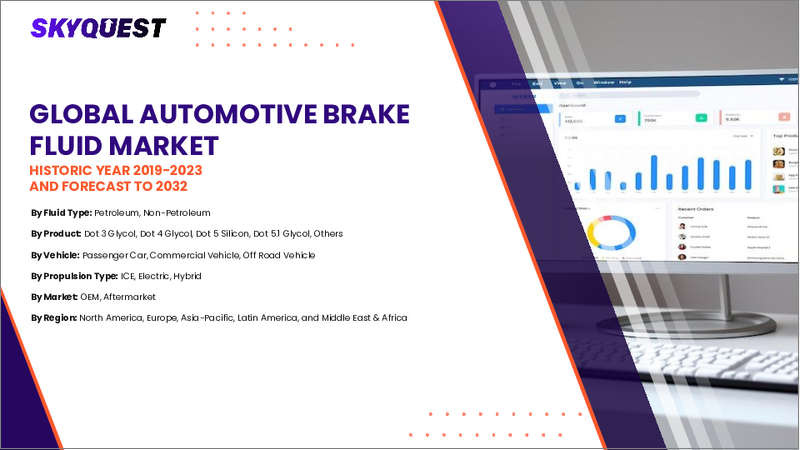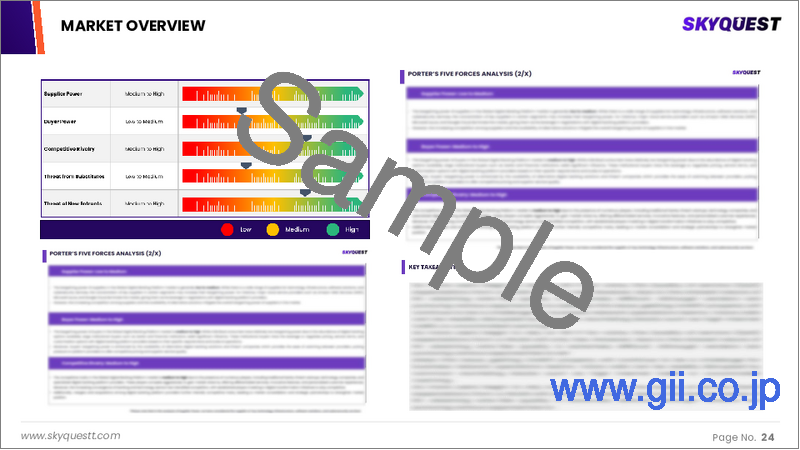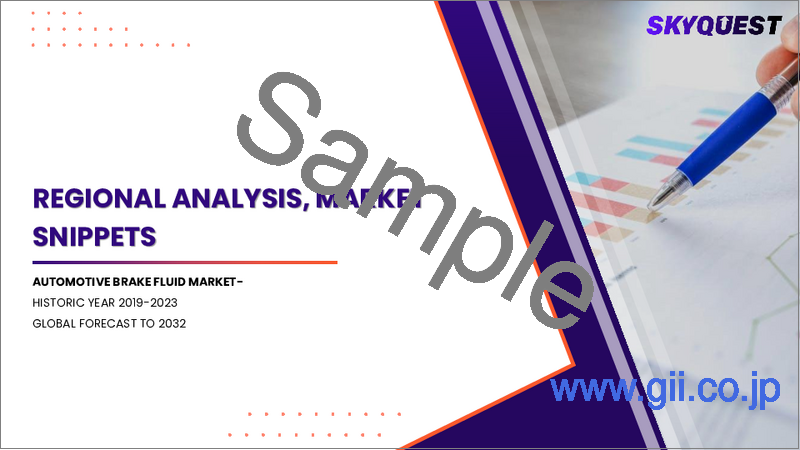|
|
市場調査レポート
商品コード
1619245
自動車用ブレーキフルード市場規模、シェア、成長分析、フルードタイプ別、製品別、車両別、市場別、地域別 - 産業別予測、2024~2031年Automotive Brake Fluid Market Size, Share, Growth Analysis, By Fluid Type (Petroleum, Non-Petroleum), By Product (Dot 3 Glycol, Dot 4 Glycol), By Vehicle, By Market, By Region - Industry Forecast 2024-2031 |
||||||
|
|||||||
| 自動車用ブレーキフルード市場規模、シェア、成長分析、フルードタイプ別、製品別、車両別、市場別、地域別 - 産業別予測、2024~2031年 |
|
出版日: 2024年12月19日
発行: SkyQuest
ページ情報: 英文 157 Pages
納期: 3~5営業日
|
全表示
- 概要
- 目次
自動車用ブレーキフルードの世界市場規模は、2022年に6,550億米ドルと評価され、2023年の6,818億5,000万米ドルから2031年には9,403億7,000万米ドルに成長し、予測期間中(2024年~2031年)のCAGRは4.1%で成長する見通しです。
ブレーキフルードオイルの需要は、自動車セクターの拡大により増加傾向にあります。主にブレーキシステムの作動油として利用されるブレーキフルードオイルは、自動車の安全性と性能を確保するために不可欠です。優れた潤滑性、非腐食性、高沸点などの主な特性により、ブレーキで遭遇する高温・高圧に対応するために不可欠です。市場にはさまざまなタイプのブレーキフルードオイルがあり、塗装面を腐食するリスクはあるもの、その堅牢な性能からグリコールベースのフルードが最も普及しています。逆に、シリコンベースのフルードは、高温性能を犠牲にするもの、耐湿性と寒冷地での用途に優れており、さまざまな気候における多様な消費者ニーズに対応しています。
目次
イントロダクション
- 調査の目的
- 調査範囲
- 定義
調査手法
- 情報調達
- 二次データと一次データの方法
- 市場規模予測
- 市場の前提条件と制限
エグゼクティブサマリー
- 世界市場の見通し
- 供給と需要の動向分析
- セグメント別機会分析
市場力学と見通し
- 市場概要
- 市場規模
- 市場力学
- 促進要因と機会
- 抑制要因と課題
- ポーターの分析
主な市場の考察
- 重要成功要因
- 競合の程度
- 主な投資機会
- 市場エコシステム
- 市場の魅力指数(2023年)
- PESTEL分析
- マクロ経済指標
- バリューチェーン分析
- 価格分析
自動車用ブレーキフルード市場規模:フルードタイプ別
- 市場概要
- 石油
- 非石油
自動車用ブレーキフルード市場規模:製品別
- 市場概要
- Dot 3グリコール
- Dot 4グリコール
- Dot 5シリコン
- Dot 5.1グリコール
自動車用ブレーキフルード市場規模:車両別
- 市場概要
- 乗用車
- 商用車
- オフロード車
自動車用ブレーキフルード市場規模:市場別
- 市場概要
- メーカー
- アフターマーケット
自動車用ブレーキフルード市場規模:地域別
- 北米
- 米国
- カナダ
- 欧州
- ドイツ
- スペイン
- フランス
- 英国
- イタリア
- その他欧州地域
- アジア太平洋地域
- 中国
- インド
- 日本
- 韓国
- その他アジア太平洋地域
ラテンアメリカ
- ブラジル
- その他ラテンアメリカ地域
- 中東およびアフリカ
- GCC諸国
- 南アフリカ
- その他中東・アフリカ
競合情報
- 上位5社の比較
- 主要企業の市場ポジショニング(2023年)
- 主な市場企業が採用した戦略
- 市場の最近の動向
- 企業の市場シェア分析(2023年)
- 主要企業の企業プロファイル
- 会社概要
- 製品ポートフォリオ分析
- セグメント別シェア分析
- 収益の前年比比較(2021-2023)
主要企業プロファイル
- Robert Bosch GmbH(Germany)
- Castrol Limited(UK)
- Exxon Mobil Corporation(USA)
- Fuchs Petrolub SE(Germany)
- China Petrochemical Corporation(Sinopec)(China)
- TotalEnergies SE(France)
- BP p.l.c.(UK)
- Royal Dutch Shell plc(Netherlands)
- PetroChina Company Limited(China)
- BASF SE(Germany)
- MOTUL(France)
- Valvoline Inc.(USA)
- Liqui Moly GmbH(Germany)
- Ravenol GmbH(Germany)
- Petro-Canada Lubricants(Canada)
- Idemitsu Kosan Co., Ltd.(Japan)
- Amsoil Inc.(USA)
- Lucas Oil Products, Inc.(USA)
結論と推奨事項
Global Automotive Brake Fluid Market size was valued at USD 655.0 billion in 2022 and is poised to grow from USD 681.85 billion in 2023 to USD 940.37 billion by 2031, growing at a CAGR of 4.1% during the forecast period (2024-2031).
The demand for brake fluid oil is on the rise, driven by the expanding automotive sector. Primarily utilized as a hydraulic fluid in braking systems, brake fluid oil is essential for ensuring safety and performance in vehicles. Its key attributes, such as excellent lubrication, non-corrosive properties, and a high boiling point, make it indispensable for handling the high temperatures and pressures encountered in brakes. The market includes various types of brake fluid oils, with glycol-based fluids being the most prevalent due to their robust performance, albeit with a risk of corrosion on painted surfaces. Conversely, silicone-based fluids excel in moisture resistance and cold weather applications, albeit at the expense of high-temperature performance, catering to diverse consumer needs across different climates.
Top-down and bottom-up approaches were used to estimate and validate the size of the Global Automotive Brake Fluid market and to estimate the size of various other dependent submarkets. The research methodology used to estimate the market size includes the following details: The key players in the market were identified through secondary research, and their market shares in the respective regions were determined through primary and secondary research. This entire procedure includes the study of the annual and financial reports of the top market players and extensive interviews for key insights from industry leaders such as CEOs, VPs, directors, and marketing executives. All percentage shares split, and breakdowns were determined using secondary sources and verified through Primary sources. All possible parameters that affect the markets covered in this research study have been accounted for, viewed in extensive detail, verified through primary research, and analyzed to get the final quantitative and qualitative data.
Global Automotive Brake Fluid Market Segmental Analysis
Global Automotive Brake Fluid Market is segmented by fluid type, product, vehicle, market and region. Based on fluid type, the market is segmented into petroleum and non-petroleum. Based on product, the market is segmented into dot 3 glycol, dot 4 glycol, dot 5 silicon and dot 5.1 glycol. Based on vehicle, the market is segmented into passenger car, commercial vehicle and off road vehicle. Based on market, the market is segmented into OEM and aftermarket. Based on region, the market is segmented into North America, Europe, Asia Pacific, Latin America and Middle East & Africa.
Driver of the Global Automotive Brake Fluid Market
The global automotive brake fluid market is primarily driven by several interconnected factors, including population growth and urbanization. As more people migrate to urban areas, the demand for vehicles increases, subsequently elevating the need for brake fluid. Economic development plays a crucial role, as rising disposable incomes enable individuals to purchase more cars, amplifying brake fluid demand. Additionally, the growing number of vehicles on the road contributes significantly to this trend. Safety concerns prompt manufacturers to adopt advanced braking systems requiring larger volumes of brake fluid. Moreover, stringent emissions regulations encourage the use of regenerative braking systems, further propelling market growth. Lastly, the surge in electric vehicles, equipped with enhanced braking technologies, also boosts brake fluid consumption.
Restraints in the Global Automotive Brake Fluid Market
The global automotive brake fluid market faces significant constraints due to various factors. Economic conditions, particularly the impact of rising inflation and a sluggish economy, have led to decreased consumer spending on new vehicles. Many individuals are choosing to prolong the use of their existing vehicles instead of purchasing or leasing new ones, resulting in reduced demand for automotive products, including brake fluid. Additionally, the rising fuel prices are prompting consumers, particularly in developing nations, to prioritize public transportation over personal vehicle use, further decreasing brake fluid consumption. Furthermore, advancements in braking technology are making brake fluid less critical, potentially diminishing its overall demand in the market.
Market Trends of the Global Automotive Brake Fluid Market
The Global Automotive Brake Fluid market is experiencing a notable upward trend driven by an intensified focus on vehicle performance. As automotive technologies advance, with enhanced power and capabilities, there is a rising demand for brake fluids that can endure elevated temperatures and pressures while maintaining optimal performance. This demand has sparked innovation, leading to the development of advanced formulations that not only improve braking feel and response but also ensure safety and reliability under extreme conditions. Consequently, this trend is substantially contributing to the growth of the automotive brake fluid market, as manufacturers respond to the evolving needs of modern vehicles.
Table of Contents
Introduction
- Objectives of the Study
- Scope of the Report
- Definitions
Research Methodology
- Information Procurement
- Secondary & Primary Data Methods
- Market Size Estimation
- Market Assumptions & Limitations
Executive Summary
- Global Market Outlook
- Supply & Demand Trend Analysis
- Segmental Opportunity Analysis
Market Dynamics & Outlook
- Market Overview
- Market Size
- Market Dynamics
- Drivers & Opportunities
- Restraints & Challenges
- Porters Analysis
- Competitive rivalry
- Threat of substitute
- Bargaining power of buyers
- Threat of new entrants
- Bargaining power of suppliers
Key Market Insights
- Key Success Factors
- Degree of Competition
- Top Investment Pockets
- Market Ecosystem
- Market Attractiveness Index, 2023
- PESTEL Analysis
- Macro-Economic Indicators
- Value Chain Analysis
- Pricing Analysis
Global Automotive Brake Fluid Market Size by Fluid Type & CAGR (2024-2031)
- Market Overview
- Petroleum
- Non-Petroleum
Global Automotive Brake Fluid Market Size by Product & CAGR (2024-2031)
- Market Overview
- Dot 3 Glycol
- Dot 4 Glycol
- Dot 5 Silicon
- Dot 5.1 Glycol
Global Automotive Brake Fluid Market Size by Vehicle & CAGR (2024-2031)
- Market Overview
- Passenger Car
- Commercial Vehicle
- Off Road Vehicle
Global Automotive Brake Fluid Market Size by Market & CAGR (2024-2031)
- Market Overview
- OEM
- Aftermarket
Global Automotive Brake Fluid Market Size & CAGR (2024-2031)
- North America (Fluid Type, Product, Vehicle, Market)
- USA
- Canada
- Europe (Fluid Type, Product, Vehicle, Market)
- Germany
- Spain
- France
- UK
- Italy
- Rest of Europe
- Asia Pacific (Fluid Type, Product, Vehicle, Market)
- China
- India
- Japan
- South Korea
- Rest of Asia-Pacific
Latin America (Fluid Type, Product, Vehicle, Market)
- Brazil
- Rest of Latin America
- Middle East & Africa (Fluid Type, Product, Vehicle, Market)
- GCC Countries
- South Africa
- Rest of Middle East & Africa
Competitive Intelligence
- Top 5 Player Comparison
- Market Positioning of Key Players, 2023
- Strategies Adopted by Key Market Players
- Recent Developments in the Market
- Company Market Share Analysis, 2023
- Company Profiles of All Key Players
- Company Details
- Product Portfolio Analysis
- Company's Segmental Share Analysis
- Revenue Y-O-Y Comparison (2021-2023)
Key Company Profiles
- Robert Bosch GmbH (Germany)
- Company Overview
- Business Segment Overview
- Financial Updates
- Key Developments
- Castrol Limited (UK)
- Company Overview
- Business Segment Overview
- Financial Updates
- Key Developments
- Exxon Mobil Corporation (USA)
- Company Overview
- Business Segment Overview
- Financial Updates
- Key Developments
- Fuchs Petrolub SE (Germany)
- Company Overview
- Business Segment Overview
- Financial Updates
- Key Developments
- China Petrochemical Corporation (Sinopec) (China)
- Company Overview
- Business Segment Overview
- Financial Updates
- Key Developments
- TotalEnergies SE (France)
- Company Overview
- Business Segment Overview
- Financial Updates
- Key Developments
- BP p.l.c. (UK)
- Company Overview
- Business Segment Overview
- Financial Updates
- Key Developments
- Royal Dutch Shell plc (Netherlands)
- Company Overview
- Business Segment Overview
- Financial Updates
- Key Developments
- PetroChina Company Limited (China)
- Company Overview
- Business Segment Overview
- Financial Updates
- Key Developments
- BASF SE (Germany)
- Company Overview
- Business Segment Overview
- Financial Updates
- Key Developments
- MOTUL (France)
- Company Overview
- Business Segment Overview
- Financial Updates
- Key Developments
- Valvoline Inc. (USA)
- Company Overview
- Business Segment Overview
- Financial Updates
- Key Developments
- Liqui Moly GmbH (Germany)
- Company Overview
- Business Segment Overview
- Financial Updates
- Key Developments
- Ravenol GmbH (Germany)
- Company Overview
- Business Segment Overview
- Financial Updates
- Key Developments
- Petro-Canada Lubricants (Canada)
- Company Overview
- Business Segment Overview
- Financial Updates
- Key Developments
- Idemitsu Kosan Co., Ltd. (Japan)
- Company Overview
- Business Segment Overview
- Financial Updates
- Key Developments
- Amsoil Inc. (USA)
- Company Overview
- Business Segment Overview
- Financial Updates
- Key Developments
- Lucas Oil Products, Inc. (USA)
- Company Overview
- Business Segment Overview
- Financial Updates
- Key Developments






